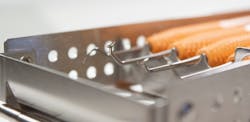Pineyro Arch Kit by PDT
Implant-retained hybrid prostheses have been an amazing option for our patients. The last decade has brought us significant advances in life-changing restorations, with plenty of focus on implant hybrids. Almost every dental conference offers a course devoted to marketing, planning, and/or execution of this niche of restorative dentistry. For every 10 or 20 of these courses, you might find one course on the maintenance of these prostheses. Unfortunately, we place so much emphasis on getting patients to say yes and on the execution of hybrids that we never think about what happens one year, three years, five years, or 10 years post-op. How can we help our patients maintain these restorations? Paradise Dental Technologies (PDT) is here to help with its newest kit, the Pineyro Arch Kit.
The Pineyro Arch Kit is the first set of instruments specifically designed for debridement of full fixed and full removable implant restorations. The Pineyro Arch Kit will give your hygiene department the necessary tools to care for complex patient cases. In addition to tools, your hygiene department also needs some protocols and systems, and PDT and Alfonso Piñeyro, DDS, can help you with that.
It starts with an assessment for categorizing these patients by risk. Patients with high risks, such as dexterity issues and heavy calculus or inflammation, should receive quarterly care. Half of those visits should involve removing the prosthesis, and half should be done with the prosthesis on. The Pineyro Kit will help in both instances. Patients with moderate risks, such as moderate inflammation, require six-month recalls and prosthesis removal only once per year. Finally, patients with little to no calculus or inflammation and good home care should be seen for maintenance once per year. The prosthesis should be removed only if needed.
Four titanium instruments are included in the kit. Pineyro Arch Ti 1 is for the anterior implants and is specially designed to help debride the lingual surfaces. Pineyro Arch Ti 2 is for the posterior implants. Pineyro Arch Ti 3 is the third instrument in the kit and sequence and should be used anywhere that Ti 1 and Ti 2 cannot reach. Pineyro Arch Ti 4 is a more standard-shaped scaler and should be used to clean and debride implants before the prosthesis is placed.
If you ask clinicians who do these maintenance visits regularly, they will tell you they dread seeing them on the schedule. The risk of complications during prosthetic removals is very high, as is the stress. Screws can break, things can go wrong, and the procedure can eat up time. It is difficult to charge a fee that is commensurate with the energy that it takes to do this well. Having tools such as the Pineyro Arch Kit, which can enable you to avoid removing prostheses as much, is huge! Ground-rule double to left-center field for PDT and the Pineyro Arch Kit!
EsteCem II adhesive resin cement by Tokuyama Dental
One of the trends in dental cements during the past few years has been pairing cements with bonding agents. There are a lot of advantages in this. I am constantly looking for ways to decrease the number of bottles I have to stock in my practice. If I choose wisely, I can select a cement that allows me to utilize my bonding agent as a primer. There are several examples of this on the market. EsteCem II is Tokuyama Dental America’s. Like a great Napa Valley cabernet paired with a prime ribeye, EsteCem II pairs with Tokuyama Dental America’s universal bonding agent, Tokuyama Universal Bond.
If you are looking for a great universal bonding agent and dual-cure self-etching resin cement, EsteCem II might be the product you have been looking for.
Tokuyama Universal Bond is the chemistry at the heart of EsteCem II. It is a novel bonding agent that provides a true universal bond and is totally dark cure. Light curing has no effect on it. Using a self-curing bonding agent as a tooth primer is great because these are designed to be used in an environment lacking light. Tokuyama Universal Bond can also be used on the intaglio surface of a crown as a pretreatment. This will preempt the use of silane or zirconia primer. This increases simplicity and decreases the number of bottles we need to have around the treatment room.
After coating the tooth and the interior of the crown with Tokuyama Universal Bond, load EsteCem II into the crown, and seat the crown. Tokuyama Universal Bond may be dark cure, but there are light-curing components in EsteCem II. This means that you can tack cure EsteCem II. After a two-second tack cure, remove the excess cement and finish.
EsteCem II has great bond strengths to enamel and dentin. It also has excellent flexural strength. Like all other dual-cure materials, the flexural strength and bond strength increase when you light cure them, so make sure you light cure the restoration after you have cleaned up all the excess. Also, EsteCem II comes in four different shades. Those shades are brown, universal, clear, and white opaque.
The one downside to using EsteCem II and Tokuyama Universal Bond is that both products must be stored in the refrigerator to maintain their long-term stability. EsteCem II should be allowed to reach room temperature before use. That means you should pull it out and set it on the counter 20 minutes prior to use. This requires some forethought on behalf of your team, so keep that in mind in your new product training if you switch to EsteCem II.
Apart from the refrigeration, EsteCem II and Tokuyama Universal Bond are a simple solution to getting a strong, esthetic bond with your indirect restorations. Base hit into center field for EsteCem II!
About the Author
Joshua Austin, DDS, MAGD
Joshua Austin, DDS, MAGD, is a graduate and former faculty member of the University of Texas Health Science Center at San Antonio School of Dentistry. Author of Dental Economics’ Pearls for Your Practice column, Dr. Austin lectures nationally on products, dental technology, online reputation management, and social media. He maintains a full-time restorative dentistry private practice in San Antonio, Texas. You may contact Dr. Austin at [email protected].
Updated June 21, 2023


